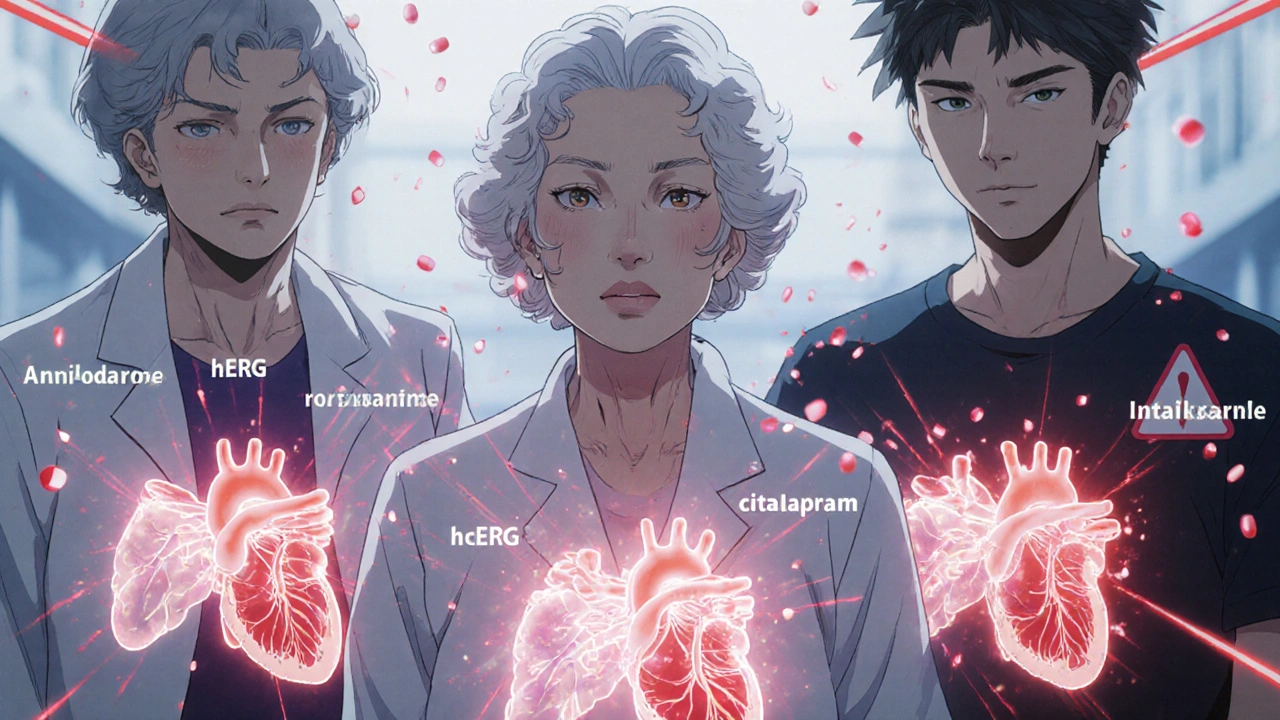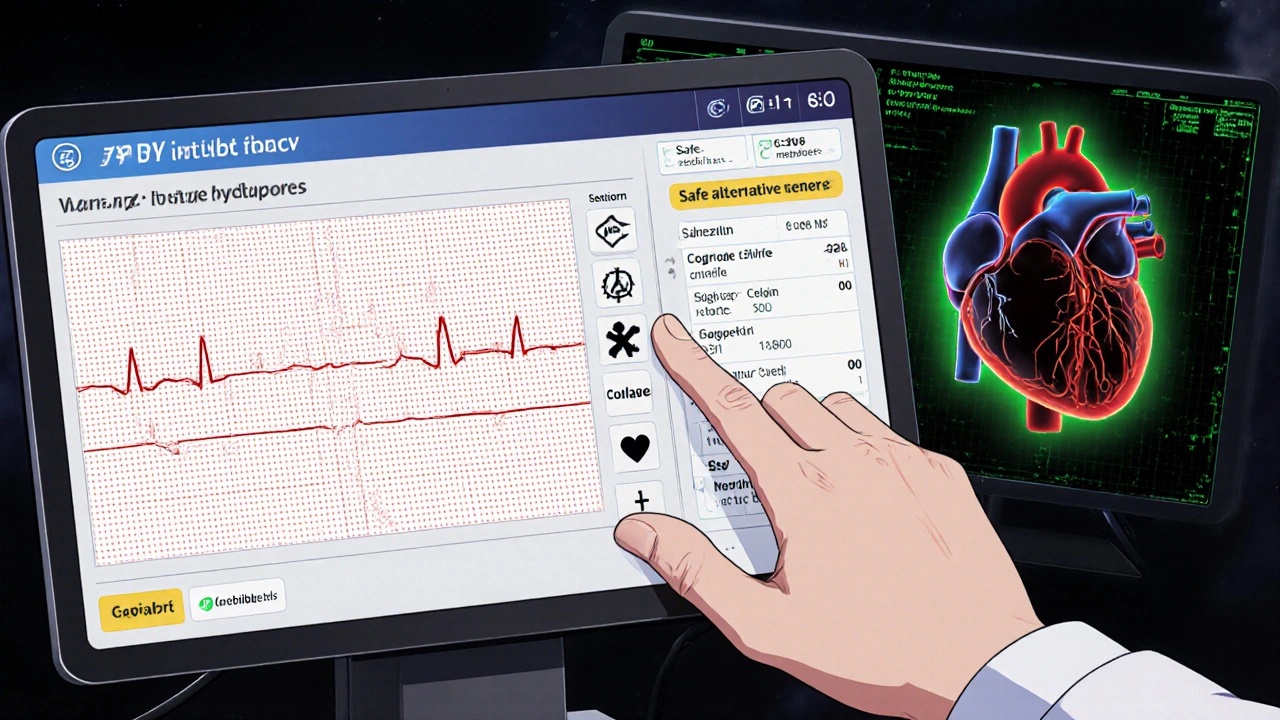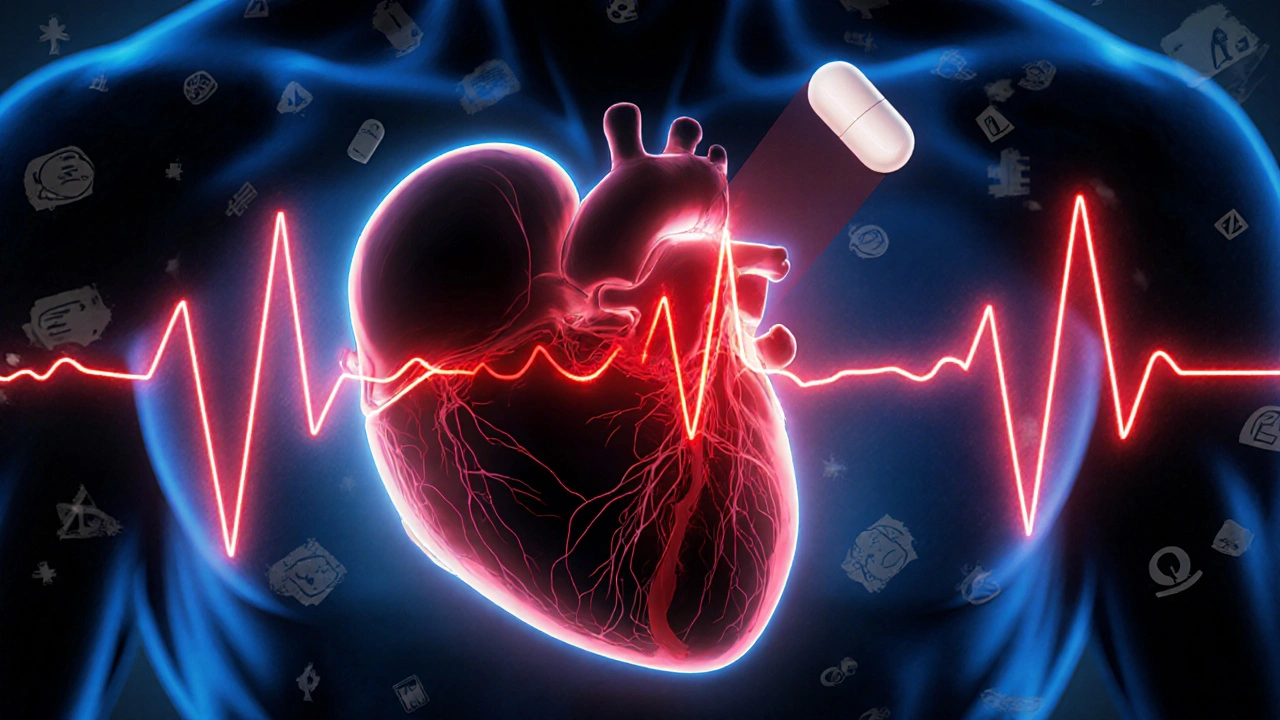Hydroxyzine QT Prolongation Risk Calculator
Patient Risk Assessment
This calculator helps assess the risk of QT prolongation when considering hydroxyzine. Based on clinical guidelines and recent evidence, it evaluates key risk factors.
Key Guidelines
Max Daily Dose:
- Adults: 100 mg
- Over 65: 50 mg
- Children: 2 mg/kg (max 40 kg)
ECG Warning: Normal QTc < 450 ms (men), < 470 ms (women)
Alternative: Consider safer antihistamines like cetirizine or fexofenadine
Risk Assessment Results
Recommendations: Hydroxyzine may be considered with caution
Important: Always review medications with CredibleMeds database (www.crediblemeds.org)
Hydroxyzine has been used for over 60 years to treat anxiety, itching, and nausea. It’s cheap, effective, and widely prescribed-especially for older adults and patients with skin conditions. But in recent years, doctors have started warning that this common antihistamine can trigger a dangerous heart rhythm problem called QT prolongation, which can lead to a life-threatening arrhythmia known as Torsade de Pointes. This isn’t theoretical. It’s happened. And it’s preventable-if you know the signs and risks.
What Is QT Prolongation, and Why Does It Matter?
Your heart beats because of electrical signals that travel through muscle tissue. The QT interval on an ECG measures how long it takes for the heart’s lower chambers to recharge between beats. If that interval gets too long, the heart can misfire, leading to chaotic, rapid rhythms. Torsade de Pointes isn’t just an abnormal ECG reading-it can cause fainting, seizures, or sudden death if not treated immediately. Hydroxyzine doesn’t cause this in everyone. But it blocks a specific ion channel in heart cells-the hERG potassium channel-that’s critical for keeping the heartbeat regular. When this channel is blocked, the heart takes longer to reset. That’s QT prolongation. And once it starts, even a small trigger-like low potassium, another medication, or just a single dose-can push the heart into dangerous territory.Who’s at Risk?
The risk isn’t the same for everyone. Hydroxyzine is generally safe for healthy, young adults with no heart issues. But certain factors turn it from a mild sedative into a potential cardiac threat:- Age over 65: Older adults clear the drug slower. Even standard doses can build up in the system.
- Low potassium or magnesium: Common in people on diuretics, with kidney disease, or poor nutrition. These electrolytes help stabilize heart rhythms.
- Other QT-prolonging drugs: Taking hydroxyzine with antibiotics like azithromycin, antidepressants like citalopram, or heart meds like amiodarone multiplies the risk.
- Pre-existing heart conditions: History of arrhythmias, heart failure, or congenital long QT syndrome.
- Slow metabolism: People with CYP2D6 gene variants (poor metabolizers) break down hydroxyzine much slower, increasing exposure.
- Dialysis patients: Often have electrolyte imbalances and are frequently prescribed hydroxyzine for itching-making them a high-risk group.
A 2022 case report described a 68-year-old woman with no prior heart disease who developed Torsade de Pointes after taking just 50 mg of hydroxyzine for anxiety. She was also on amiodarone. That combination was a recipe for disaster.
Dosing Limits and Regulatory Changes
Back in the 1990s, doctors sometimes prescribed up to 300 mg of hydroxyzine per day. That’s no longer acceptable. In 2015, after reviewing over 50 documented cases of QT prolongation and Torsade de Pointes linked to hydroxyzine, the European Medicines Agency (EMA) made major changes:- Maximum daily dose for adults: 100 mg (down from higher, unregulated amounts)
- Maximum daily dose for adults over 65: 50 mg
- Children: 2 mg per kg of body weight, up to a maximum of 40 kg
The FDA followed suit, adding hydroxyzine to its official list of drugs with known QT prolongation risk in 2019. Prescribing information now includes strong warnings about cardiac monitoring.
These changes didn’t come out of nowhere. Between 1955 and 2016, 59 confirmed cases of QT prolongation or Torsade de Pointes were linked to hydroxyzine. Before 2015, there were only a handful of case reports. Now, we know the pattern.

How Hydroxyzine Compares to Other Antihistamines
Not all antihistamines carry the same risk. Here’s how hydroxyzine stacks up:| Drug | Generation | QT Prolongation Risk | hERG Inhibition |
|---|---|---|---|
| Hydroxyzine | First | Known Risk (CredibleMeds) | High |
| Diphenhydramine | First | Possible Risk | Moderate |
| Cetirizine | Second | Minimal Risk | Very Low |
| Loratadine | Second | Minimal Risk | Very Low |
| Fexofenadine | Second | Very Low Risk | Negligible |
Second-generation antihistamines like cetirizine and loratadine barely touch the hERG channel. They’re safer choices for long-term use, especially in older patients. Hydroxyzine, on the other hand, binds tightly to the channel-even at low doses-making it one of the riskiest first-generation options.
What Doctors Should Do Before Prescribing
If you’re a provider, here’s the bare minimum you need to check before writing a prescription for hydroxyzine:- Check the QTc interval with a 12-lead ECG. Normal is under 450 ms for men, under 470 ms for women. Anything above 500 ms? Don’t use hydroxyzine.
- Review all medications using the CredibleMeds database. If the patient is on another drug marked ‘Known Risk’ for TdP, avoid hydroxyzine.
- Test electrolytes. Potassium below 4.0 mmol/L? Magnesium below 1.8 mg/dL? Correct those first.
- Ask about heart history. Any past fainting spells? Unexplained seizures? Family history of sudden cardiac death?
- Use the lowest effective dose. For anxiety or itching, 10-25 mg may be enough. Avoid daily chronic use.
- Document your assessment. Many hospitals now require a checkbox in the EHR confirming cardiac risk review.
One 2022 study found that after hospitals implemented these checks, compliance jumped from 45% to 78%. And the number of cardiac events dropped.
What Patients Should Watch For
If you’re taking hydroxyzine, pay attention to your body:- Dizziness or lightheadedness-especially right after taking the pill
- Palpitations or feeling like your heart skipped a beat
- Fainting or near-fainting episodes
- Unusual fatigue that doesn’t go away
These symptoms can show up within 10 minutes or up to 20 days after starting the drug. Don’t ignore them. Call your doctor. Get an ECG.
One Reddit user reported feeling their heart "flip-flop" 45 minutes after taking 25 mg. They didn’t think much of it-until they passed out the next day. Turns out, they had undiagnosed long QT syndrome. Hydroxyzine triggered their first cardiac event.

Alternatives to Hydroxyzine
If you’re on hydroxyzine for anxiety or itching, there are safer options:- For anxiety: Low-dose SSRIs like sertraline, or buspirone. Non-pharmacological options like CBT are also effective.
- For itching: Cetirizine, fexofenadine, or gabapentin (especially for chronic kidney disease-related itching). Topical corticosteroids or calcineurin inhibitors work for localized skin issues.
- For sleep: Melatonin, diphenhydramine (with caution), or mirtazapine (low dose) are better than hydroxyzine for older adults.
Since 2015, prescriptions for gabapentin for pruritus have risen 62%. Mirtazapine use for insomnia in older patients jumped 45%. These aren’t just trends-they’re responses to real safety data.
The Future of Hydroxyzine
Hydroxyzine isn’t going away. It’s still useful for short-term procedural sedation or acute itching. But its role is shrinking.- The American Geriatrics Society now lists it as a Potentially Inappropriate Medication for older adults.
- Research is underway to develop new versions of hydroxyzine that don’t block hERG channels. One candidate, VH-01, shows 87% less hERG inhibition in early trials.
- Genetic testing for CYP2D6 poor metabolizers may soon become standard before prescribing.
- By 2025, the European Society of Cardiology is expected to ban chronic hydroxyzine use entirely-limiting it to single doses for anxiety before procedures.
As one cardiologist put it: "Hydroxyzine isn’t inherently dangerous. But we’ve learned it needs the same level of cardiac vigilance as a blood thinner or antiarrhythmic. The era of treating it like a harmless bedtime pill is over."
Can hydroxyzine cause heart problems even if I’m young and healthy?
Yes, but it’s rare. Most cases occur in people with other risk factors like low potassium, another QT-prolonging drug, or undiagnosed heart conditions. Healthy young adults with no other medications and normal ECGs are at very low risk. Still, if you feel dizzy, faint, or have palpitations after taking it, stop and get checked.
Is hydroxyzine safe for seniors?
Only if absolutely necessary, and only at a maximum of 50 mg per day. Seniors metabolize the drug slower, so even standard doses can build up. Many older adults also take other medications or have electrolyte imbalances. The American Geriatrics Society recommends avoiding hydroxyzine entirely in people over 65 unless no safer option exists.
How do I know if a drug I’m taking also prolongs the QT interval?
Use the CredibleMeds website (www.crediblemeds.org). It’s free and lists drugs by risk level: Known Risk, Possible Risk, or No Risk. Hydroxyzine is in the "Known Risk" category. If you’re taking two or more drugs from the "Known Risk" list, don’t combine them.
Do I need an ECG before taking hydroxyzine?
If you’re over 65, have heart disease, take other medications, or have electrolyte issues-yes. Even if you’re young and healthy, if you’re taking hydroxyzine for more than a few days, a baseline ECG is a smart precaution. Many hospitals now require it before prescribing.
What should I do if I’ve been taking hydroxyzine for months?
Stop taking it immediately if you’re over 65, have heart issues, or are on other QT-prolonging drugs. Talk to your doctor about switching to a safer alternative like cetirizine, gabapentin, or a low-dose SSRI. Don’t quit cold turkey if you’re using it for anxiety-your doctor can help you taper safely.



Cinkoon Marketing
November 20, 2025 AT 14:52Okay but like... why is everyone acting like this is new? I’ve been telling my grandma for years not to take hydroxyzine for sleep. She’s 72, on a diuretic, and still swallows that blue pill like candy. Her cardiologist didn’t even blink when she mentioned it. The system’s broken.
And don’t even get me started on how pharmacies still sell it OTC in Canada under ‘allergy relief’ labels. We’re not even close to being on the same page as the science.
Also, why is cetirizine so much cheaper than hydroxyzine? It’s literally safer and just as effective for itching. Someone’s making bank off outdated prescriptions.
robert cardy solano
November 21, 2025 AT 13:09Been on hydroxyzine for anxiety for 8 years. 25mg at night. Never had an issue. No dizziness, no palpitations. My ECGs are clean. I’m 34, no other meds, healthy diet.
So yeah, it’s risky for some. But blanket warnings like this make people scared of everything. If you’re not in the risk group, don’t panic. Just don’t mix it with azithromycin or amiodarone and you’ll be fine.
Dave Wooldridge
November 21, 2025 AT 21:19THIS IS A BIG PHARMA COVER-UP. They’ve known about this since the 80s. The FDA only acted because someone leaked internal emails showing they buried 17 deaths linked to hydroxyzine. They didn’t want to lose billions from this $2 pill.
And now they’re pushing ‘safer’ alternatives like gabapentin? LOL. That stuff causes suicidal thoughts and weight gain. They just swapped one poison for another.
They’re testing VH-01? Yeah, right. It’s already patented by Pfizer. You think they care about safety? They care about the next patent. Wake up.
And why are they banning it in Europe but still selling it here? Coincidence? I think not. The FDA is bought. Always has been.
swatantra kumar
November 23, 2025 AT 06:25Bro this is wild 😳 I took hydroxyzine last week for hives and felt weirdly tired but thought it was just allergies. Now I’m scared to even look at my pill bottle.
But hey, at least we got CredibleMeds now 🙌 Free tool, no ads, just pure lifesaving data. Why don’t more docs use it? 🤔
Also, if you’re in India, gabapentin is like $0.10 a pill. Why are we still using this old-school stuff? Time to upgrade, folks 🚀
Pawan Jamwal
November 23, 2025 AT 11:51USA and Europe acting like they discovered fire. In India, we’ve been avoiding hydroxyzine for elderly patients since 2010 because our doctors know better. We have 1.4 billion people - we can’t afford to be careless.
And now they’re talking about genetic testing? We’ve been doing it for years. CYP2D6 testing is standard in major hospitals here. You think you’re advanced? We were ahead.
Stop pretending this is a Western medical breakthrough. The real science came from the Global South.
Also, why is cetirizine so expensive in the US? Because you pay for patents, not medicine. We buy it for 10 rupees. 🇮🇳💪
Bill Camp
November 23, 2025 AT 20:05Hydroxyzine is a weapon of mass sedation. It’s not just a pill - it’s a corporate tool to keep the elderly quiet. You think they give it to Grandma because it helps her sleep? No. They give it to her because it keeps her from asking questions. Keeps her from falling. Keeps her from complaining.
And now they want to ban it? Too late. Millions are already hooked. This isn’t about safety. It’s about control.
They’ll replace it with something more expensive. Something they own. Something that needs a subscription. That’s the real story.
Lemmy Coco
November 25, 2025 AT 01:23so i’ve been on hydroxyzine for like 4 years? 10mg for anxiety and it’s been fine. i got my ekg done last year just to be safe and it was normal. i don’t take any other meds. i eat bananas and drink water. maybe i’m just lucky?
but i’m gonna ask my dr about switching to cetirizine anyway. just in case. i don’t want to be that guy who ignores the warnings until it’s too late. also i think i might have a typo in this comment. sorry.
rob lafata
November 25, 2025 AT 01:47You people are so fucking naive. You think the FDA gives a shit about your QT interval? They care about liability. They only updated the label after a lawsuit from a widow whose husband dropped dead after a 50mg dose. They didn’t act because they gave a damn - they acted because they got sued.
And now you’re all acting like you’re saving lives by switching to cetirizine? Please. That shit still has *some* hERG binding. It’s just less. You’re not safe - you’re just less dead.
And don’t get me started on ‘genetic testing’. You think your 78-year-old mom with dementia and 12 meds is getting a DNA test? Nah. She’s getting hydroxyzine because it’s cheap and the nurse doesn’t have time to argue.
This isn’t medicine. It’s a fucking gamble with a 1 in 5000 chance of dying. And the system is fine with that.
Matthew McCraney
November 26, 2025 AT 17:54my uncle died from torsade after taking hydroxyzine and zoloft together. he was 69. he didn’t even know what qt prolongation was. the pharmacist didn’t warn him. the doctor didn’t check his electrolytes. they just said ‘take this for anxiety’.
now i’m terrified of every pill. i don’t trust doctors anymore. i don’t trust pharmacies. i don’t trust the FDA. they’re all in on it. they’re all getting kickbacks from big pharma.
and now they want us to use gabapentin? that’s the same drug that made my cousin try to jump out a window. so what’s the difference? just a different way to die.
i’m going off all meds. going raw. meditating. drinking lemon water. maybe god will save me.
serge jane
November 28, 2025 AT 04:22There’s a deeper question here that no one’s asking. Why do we treat anxiety and itching with drugs that sedate the nervous system instead of addressing the root causes? Why is the default response always a pill? Hydroxyzine isn’t the villain - our entire medical model is.
We’ve turned human suffering into a chemical equation. If you’re anxious, give a sedative. If you’re itchy, give an antihistamine. We don’t ask why. We don’t explore lifestyle. We don’t consider trauma or environment or community.
Yes, hydroxyzine has risks. But the bigger risk is the belief that a pill can fix everything. The real danger isn’t the hERG channel. It’s the belief that medicine should be simple. It’s not. Human beings aren’t simple.
Maybe the answer isn’t a safer antihistamine. Maybe the answer is a system that listens.
And if you’re reading this and you’re taking hydroxyzine - I’m not judging you. I’m just wondering what you’re trying to quiet.
robert cardy solano
November 28, 2025 AT 13:02Actually, I just checked my meds. I’m on amiodarone. Shit. I’ve been taking hydroxyzine for months. I’m gonna call my cardiologist tomorrow. Thanks for the wake-up call.
And yeah, I’m switching to cetirizine. Even if it’s less sedating, I’d rather be awake and alive.